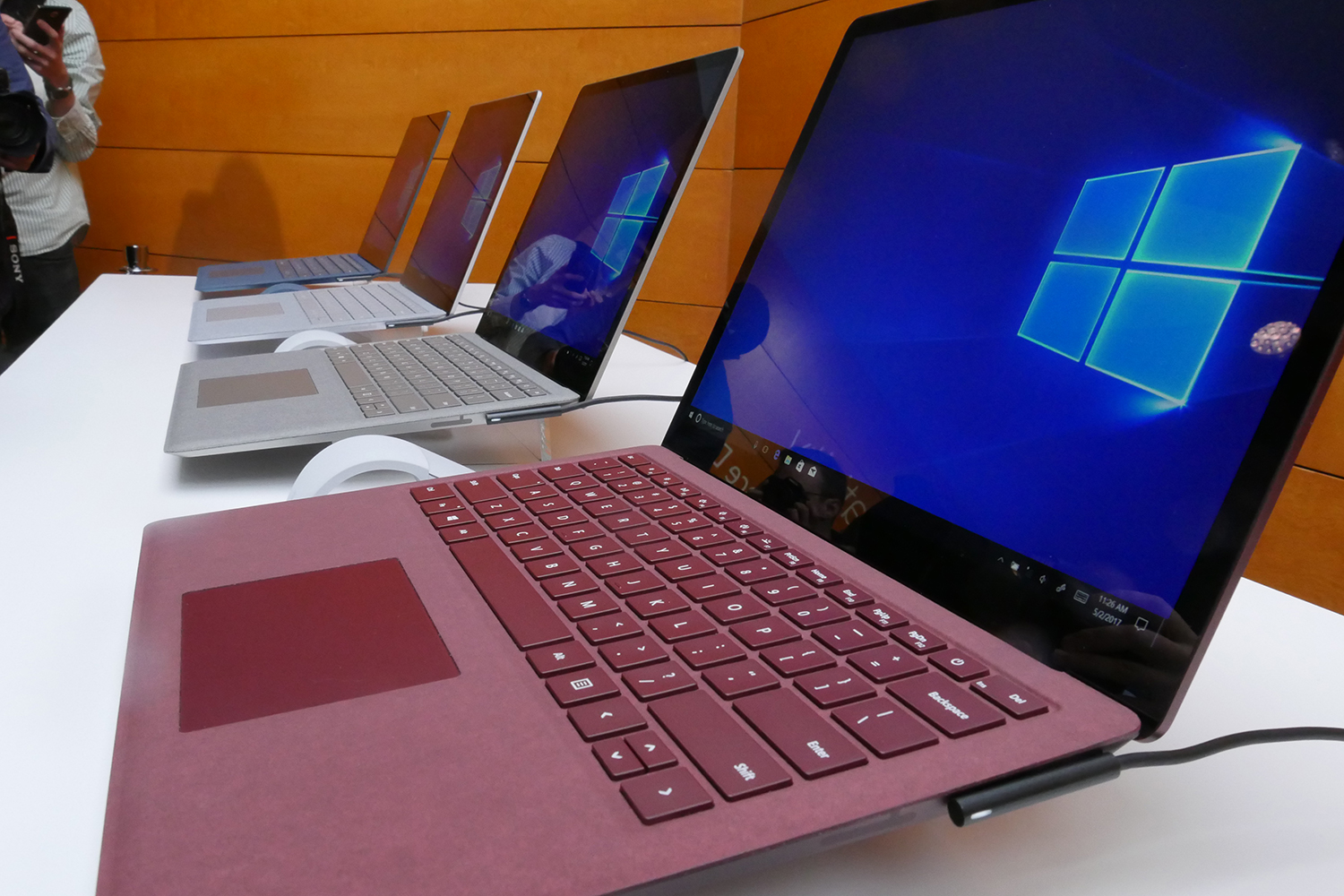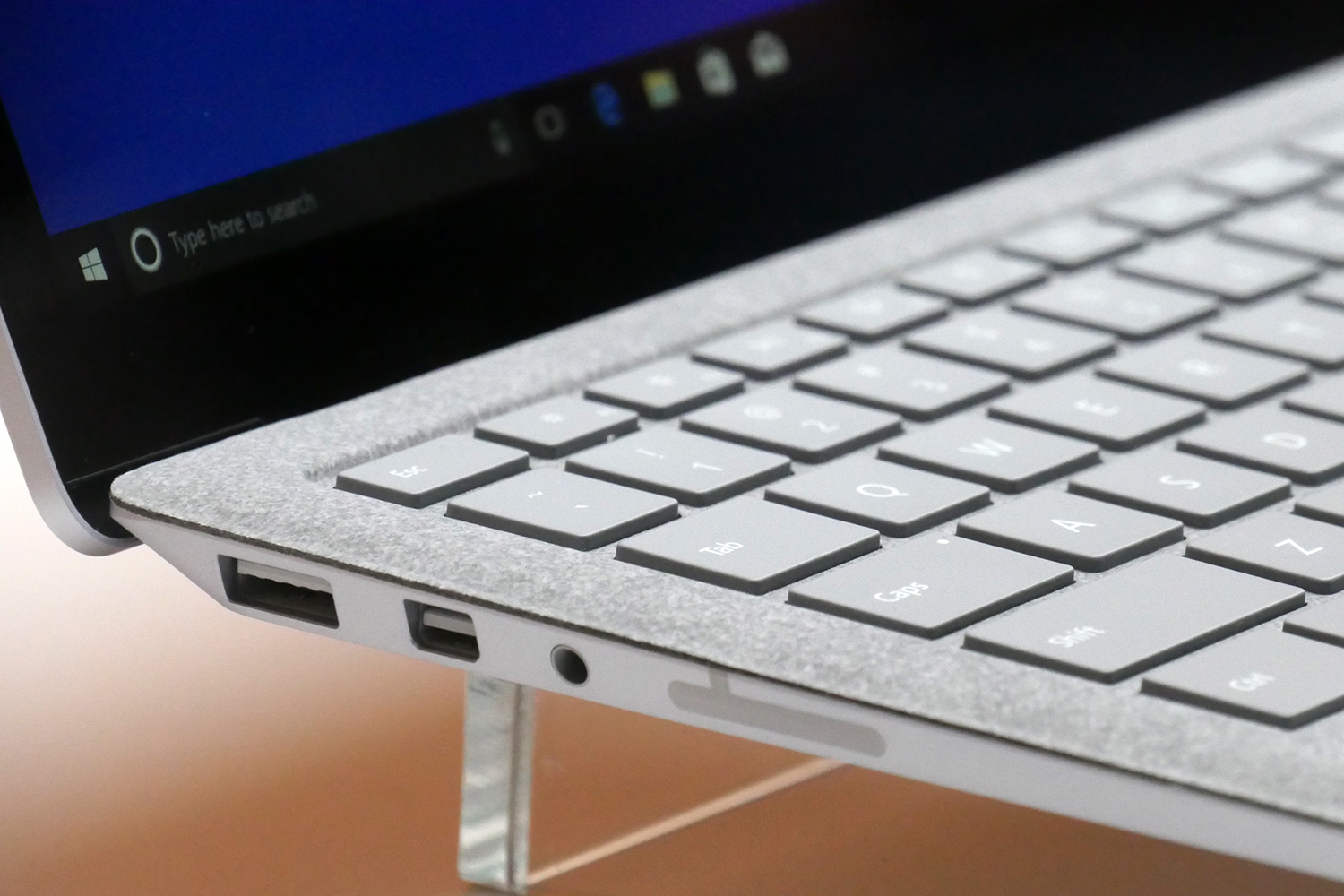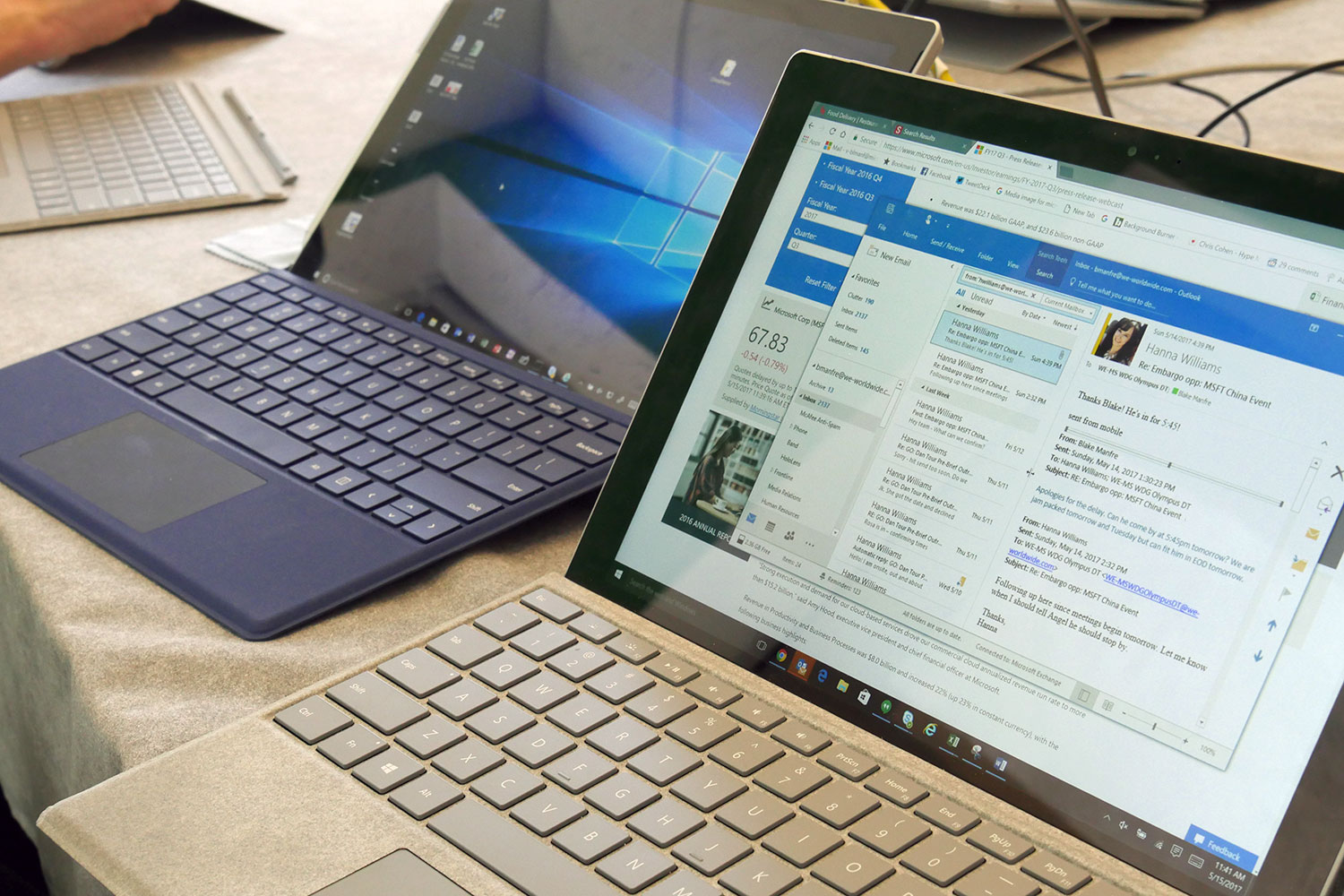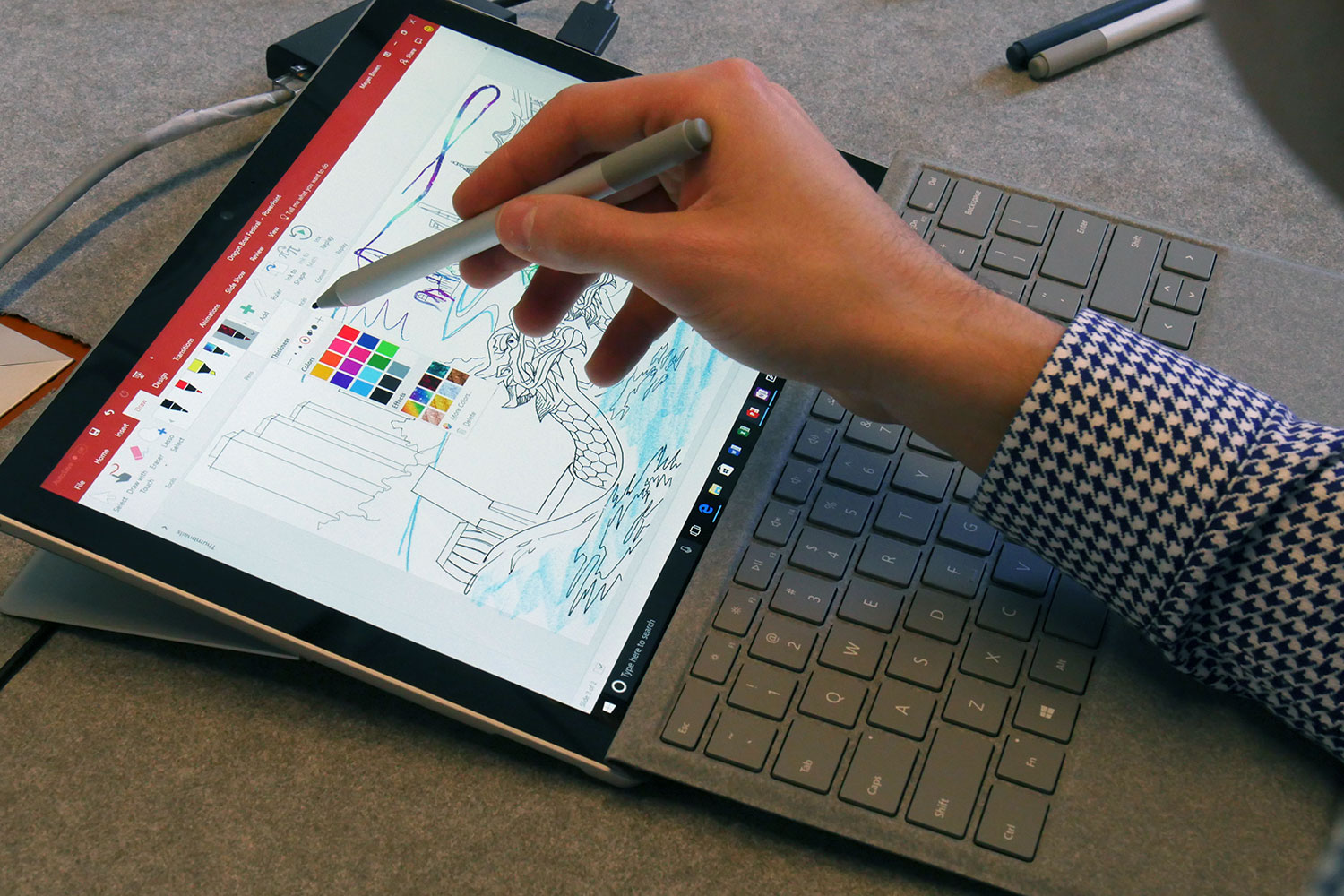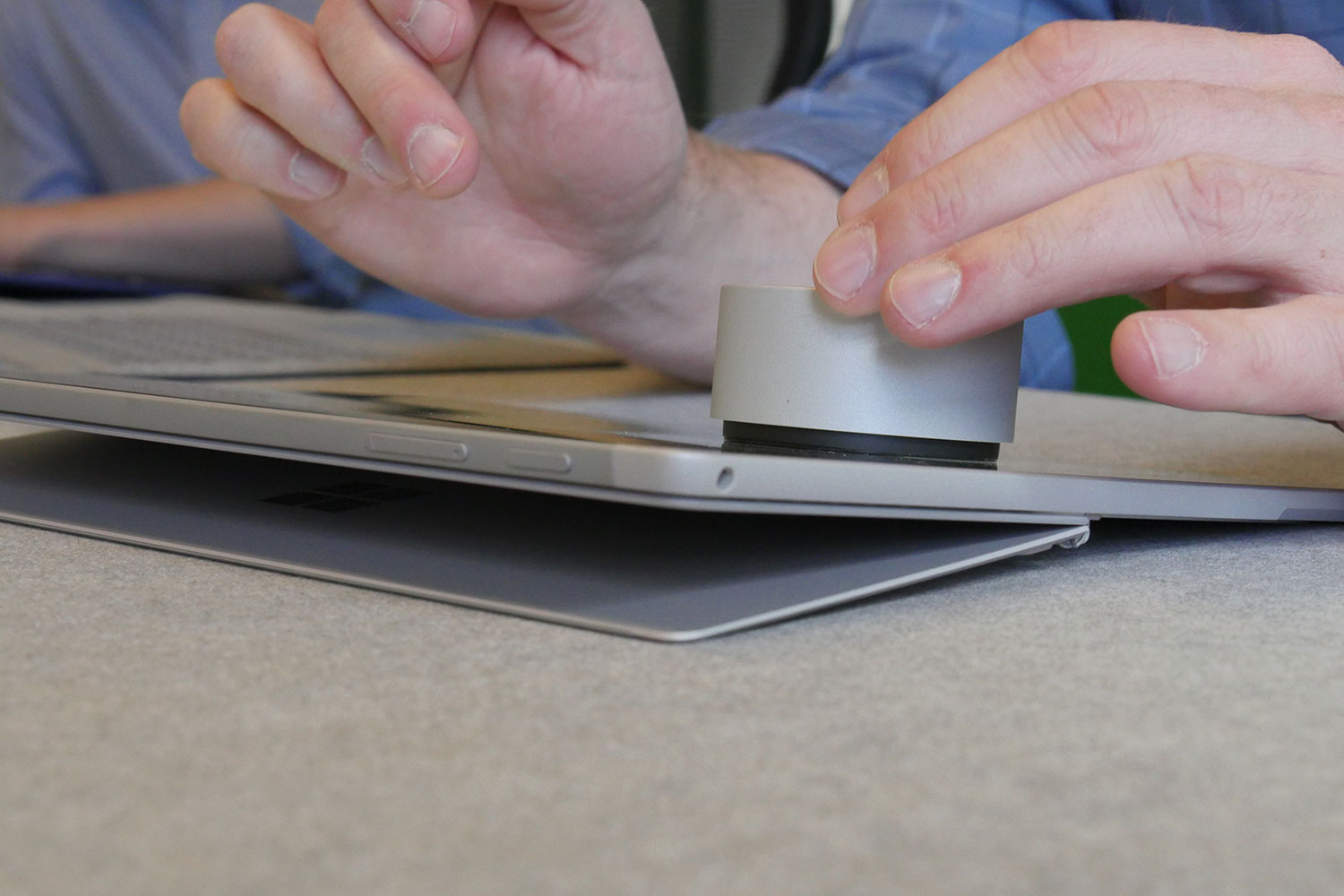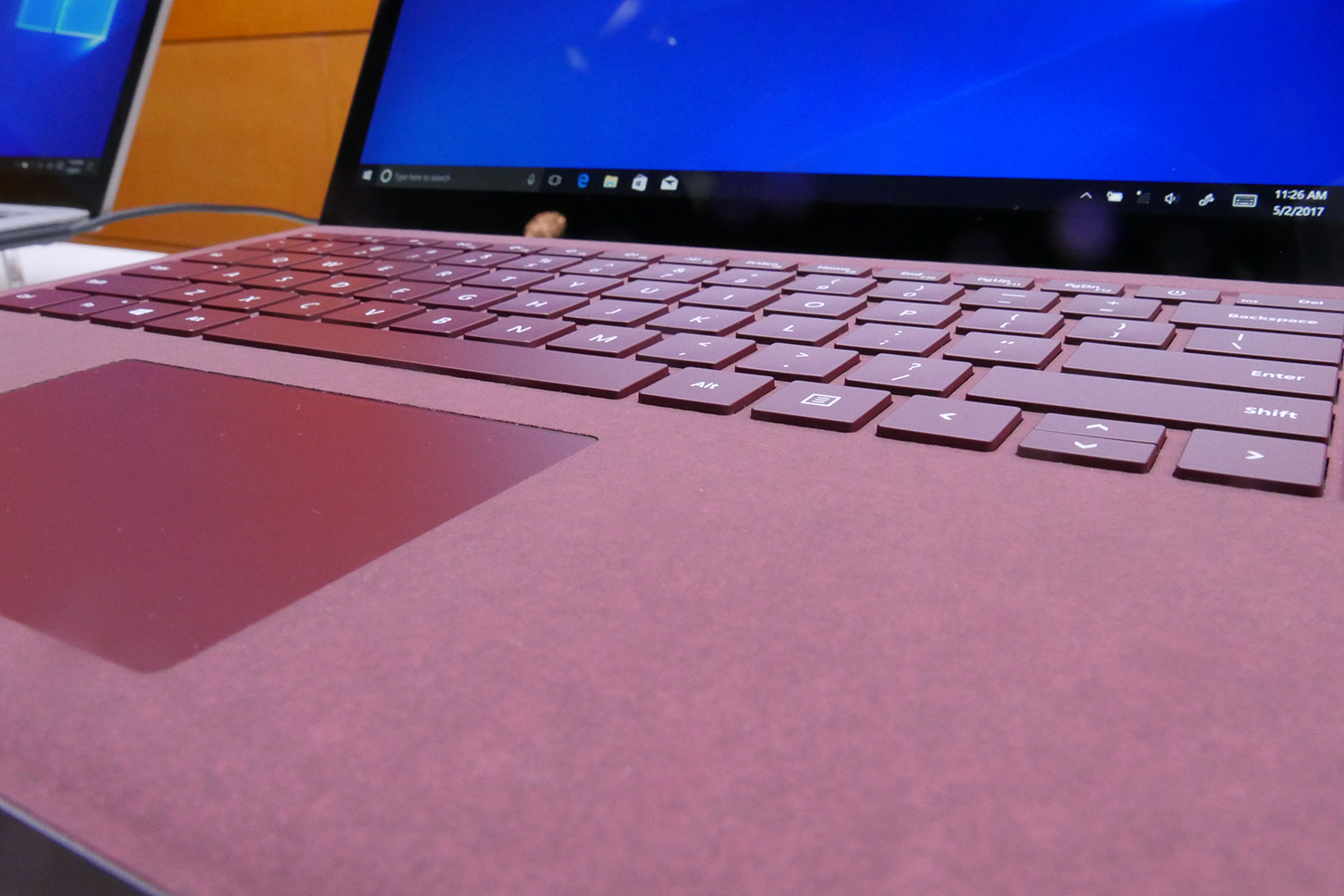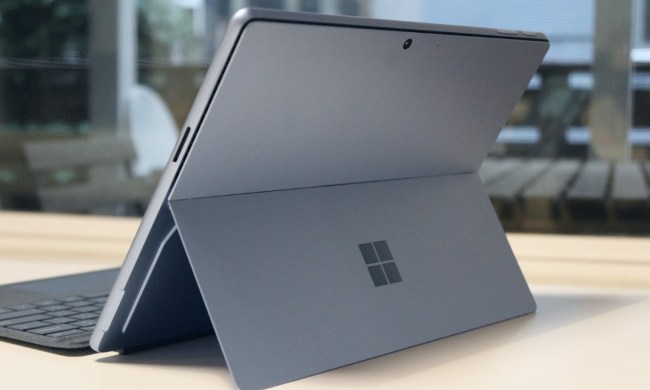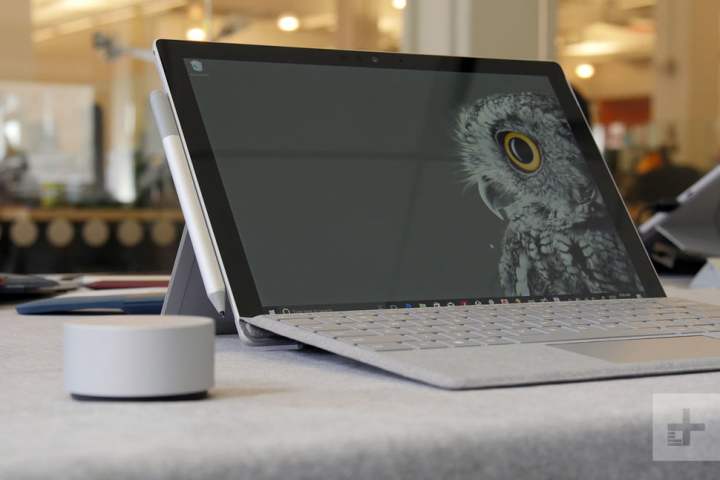
Inside, the Surface Pro and Surface Laptop bear a striking resemblance to one another, especially given both have adopted new color schemes and matching accessories. They’re also similarly equipped in the hardware department, when it comes to processing power, RAM, and storage. It’s as if Microsoft engineered two different species from the same genetic material.
But which machine is right for you? Below, we pitted the two directly against one another in an effort to suss out the details.
Specifications by-the-numbers
|
Surface Laptop  |
Surface Pro (2017)  |
|
| Dimensions | 12.13 x 8.79 x .57 (in) | 11.50 x 7.9 x 0.33 (in) |
| Weight | 2.76 pounds | 1.69 – 1.73 pounds |
| Processor | 7th-generation Intel Core i5 or i7 | 7th-generation Intel Core m3, i5, or i7 |
| RAM | 4G, 8GB, or 16GB | 4GB, 8GB, or 16GB |
| Display | 13.5-inch PixelSense display | 12.3-in PixelSense display |
| Resolution | 2,256 × 1,504 | 2,736 x 1,824 |
| Storage | 128GB, 256GB, 512GB, 1TB SSD | 128GB, 256GB, 512GB, 1TB SSD |
| Networking | 802.11ac, Bluetooth 4.2 | 802.11ac, Bluetooth 4.2, optional LTE |
| Ports | USB Type-A 3.0, mini-DisplayPort, Surface Connect port, 3.5mm headset | USB Type-A, mini-DisplayPort, Surface Connect Port, 3.5mm headset jack, microSDXC card reader |
| Webcam | 720p HD with infrared camera for Windows Hello support | 5.0MP 1080p front-facing camera with infrared camera for Windows Hello support, 8.0MP 1080p rear-facing autofocus camera |
| Operating System | Windows 10 S, upgradeable to Windows 10 Pro | Windows 10 |
| Battery | Up to 14.5 hours | Up to 13.5 hours |
| Price | $999+ | $799+ |
| Availability | Available June 15 | Available June 15 |
| Review | Hands-on | Hands-on |
Similar designs, different materials
Microsoft has done a masterful job in creating a design aesthetic for the Surface line that maintains the brand’s identity but isn’t simply cookie cutter. The Surface Pro and Surface Laptop are obviously of the same family, but each looks and feels like it should for the kind of machine it is. They’re both solidly build with the usual Surface quality and attention to detail, and they both incorporate a splash of color with Alcantara fabric surrounding the keyboard.
Of course, they’re also completely different machines. The Surface Laptop is — as the name implies — a traditional clamshell notebook without any kind of convertibility. The Surface Pro, on the other hand, is a tablet that turns into a notebook-style machine when the Type Cover keyboard is snapped on. In fact, Microsoft stopped calling the Surface Pro a “tablet that can replace your notebook” and just refers to it generically as a “laptop.” Tricky.
In terms of specifics, the Surface Laptop is machined from a chunk of aluminum, eschewing the magnesium alloy used on other Surface devices. It’s very thin for a notebook at 0.57 inches, and light at 2.76 pounds, making it thinner and lighter than Apple’s MacBook Pro 13. The Surface Laptop is a wedge design, meaning that it tapers from its thickest point at the rear down to very thin at the front, which results in a more comfortable typing angle. It also incorporates the aforementioned Alcantara fabric on the keyboard deck that comes in four colors — platinum, burgundy, cobalt blue, and graphite gold — and the optional Surface Pen comes in the same color scheme. Notably, the Surface Laptop carries the same color scheme throughout its chassis and is, therefore, a very colorful machine as well.
The Surface Pro is made from the company’s usual magnesium alloy, and it’s very similar to the previous generations, only with slightly rounded edges. It’s a touch thinner and lighter, at 0.33 inches and a maximum of 1.73 pounds, but not by much, demonstrating that Microsoft found a comfortable mix of design and materials and then stuck with it. Attach the new keyboard and the combination weighs in at 2.41 pounds, which is similar to the Surface Laptop when fully assembled.
Speaking of, the new Signature Type Covers are slightly improved over the previous models and are covered in Alcantara fabric in platinum, burgundy, cobalt blue, or black. The Surface Pen can be color matched as well, but isn’t included with the tablet — or rather, laptop — this time around. The Surface Pro itself is the same magnesium silver as past Surface devices, and thus features a more muted design overall.
It’s hard to pick a winner between these two machines. They’re both similarly thin and light when all of the required accessories are taken into account, and they’re both well-built and very attractive machines. You can’t even fault one over the other in terms of notebook versus 2-in-1 because either form factor can be right or wrong depending on a given user’s requirements.
Winner: Tie
Great display vs. even better display
If there’s one thing Microsoft got right with the Surface line, it’s its choice in displays. First, it switched to the 3:2 aspect ratio with the Surface Pro 3, which is taller than the common 16:9 widescreen ratio and better for productivity. There’s some letterboxing when watching video, but you get to see more of your documents. Second, Microsoft uses high-resolution and high-quality displays that are sharp, offer excellent contrast with deep blacks, and provide solid color support. No matter which Surface you buy, you’re guaranteed to get one of the best displays around.
The display on the Surface Laptop is a 13.5-inch PixelSense panel with 2,256 x 1,504 resolution, or 201PPI. It features Corning Gorilla Glass for scratch and shatter resistance, and it supports 10-point multitouch and the Surface Pen. A 720p HD webcam sits above the display where it belongs, and an infrared camera provides Windows Hello support via facial recognition.

The Surface Pro sports a 12.3-inch PixelSense display with 2,736 x 1,824 resolution, or 267PPI — making it one of the sharpest “laptop” displays around. It’s also protected by Corning Gorilla Glass, and offers 10-point multitouch and Surface Pen support. The Surface Pro’s active digitizer has been enhanced with a hardware accelerator and quadruples the pressure sensitivity at 4,096 levels, and so it’s the best-performing and most accurate of all the Surface devices for drawing and handwriting on the screen. A 5-megapixel, 1080p HD webcam is on front, with Windows Hello support via infrared camera and facial recognition, and there’s an 8-megapixel camera with autofocus and 1080p video support on the back.
Again, it’s difficult to pick a winner here. These are excellent displays with high resolutions — albeit, neither are 4K UHD — and the same 3:2 aspect ratio. They both support touch and pen input, although both make far more sense on the detachable Surface Pro. You really can’t go wrong with either. We’re going to give the nod here to the Surface Pro, however, given its higher sharpness and its superior pen specifications. Plus, it’s simply a more natural device for Windows Inking.
Winner: Surface Pro
Very similar for typing and touching
Microsoft’s most recent Type Covers have always provided a solid typing experience, with some points taken away for providing a slightly less stable experience when the keyboard is magnetically attached at an angle.
Microsoft has used a similar keyboard design on the Surface Laptop, and of course, the use of Alcantara fabric across the board means that the Surface Pro and Surface Laptop are going to feel very similar when in use. Both keyboards offer 1.5-millimeter travel, and a similar feel.
The touchpads are also similar, with Microsoft Precision Touchpad support, multitouch capability, and a glass surface. The Surface Laptop’s touchpad appears to be a bit larger, however, and that counts for something.
It’s becoming a theme in this comparison, but again, picking a winner is difficult. If you went back and forth between the two machines, you would be hard-pressed to tell the difference in the typing and touchpad experience. However, the Type Cover does bounce around a little when typing, and isn’t as spacious, so we think the Surface Laptop edges out the Surface Pro here.
Winner: Surface Laptop
Almost identical hardware
The Surface Laptop utilizes Intel Core i5 and i7 processors, with the former offering Intel HD 620 graphics and the latter bumping up to Intel Iris Plus 640 graphics. UP to 16GB of RAM can be configured, and up to a 1TB PCIe SSD can be selected (eventually, but just 512GB for now). All of that makes the Surface Laptop competitive on paper with other thin-and-light notebooks.
The Surface Pro offers a wider range of processors, including the low-power Intel Core m3, Core i5, and Core i7. Notably, the Core m3 and Core i5 models are fanless, meaning they’ll be completely silent in operation but could theoretically slow down more quickly when they heat up. The Core i7 also promises quieter fans than previous generations. The Surface Pro can be configured with up to 16GB of RAM and up to a 1TB PCIe SSD, and it also offers Intel Iris Plus 640 graphics with the Core i7 option.
Obviously, it’s reasonable to expect these peers to perform similarly. The big difference is the availability of a less powerful Core m3 chip in the Pro, which is not available in the Laptop.
Winner: Tie
Both are limited to the past when it comes to plugging in
Microsoft has taken a curious position regarding the increasingly ubiquitous USB Type-C connection. While most manufacturers are moving steadily in the direction of this futuristic connectivity, Microsoft believes that the USB Type-C connection is basically too confusing for its customers. We tend to think that’s a bit silly, and that it’s a real shame that Microsoft left off a port that would provide some additional longevity.

That said, the Surface Laptop and Surface Pro both offer similarly limited connectivity. Both have a single USB 3.0 Type-A port, a mini-DisplayPort, the Surface Connect port, and a 3.5-millimeter headphone jack. The Surface Pro, however, includes a Type Cover connector and microSD card reader.
We’re disappointed with the connectivity of both machines. However, the Surface Pro can at least more easily transfer some images from a camera given its microSD card reader, and so we’ll grudgingly give that machine the win in this category.
Winner: Surface Pro
The laptop lasts longer than the 2-in-1
As mentioned above, both the Surface Laptop and Surface Pro are thin and light machines for their respective categories. And, when you attach the Type Cover to the Surface Pro, the two machines become even more alike in terms of tossing in a backpack and carrying around. The Surface Laptop is a larger machine because of its larger display, but there’s remarkably little difference between the two machines otherwise.
The same can be said for battery life, where Microsoft has made some promising strides. On paper, at least, and depending on the configuration, Microsoft is promising 14.5 hours of battery life with the Surface Laptop and 13.5 hours with the Surface Pro. That gives the Laptop a small victory here.
Winner: Surface Laptop
Pricing and availability
The Surface Laptop was introduced at Microsoft’s recent education-oriented event, which was odd considering that it’s not at all an inexpensive machine. Microsoft anticipates that it will be popular among college students who might otherwise gravitate toward a MacBook, but otherwise, it’s not going to make its way into many classrooms. It starts at $999 with a Core i5, 4GB of RAM, and 128GB SSD, and jumps all the way up to $2,199 with a Core i7, 16GB of RAM, and a 512GB SSD.
The Surface Laptop comes standard with the limited Windows 10 S, which only allows apps to be installed from the Windows Store. That’s not going to be popular with many buyers of this class of machine, and it makes us wonder exactly what Microsoft is planning. It’s easy enough to upgrade to Windows 10 Pro, however, and that’s free until the end of 2017 when the upgrade will cost $49.

The Surface Pro is priced similarly to the Surface Pro 4, though the as-yet-unpriced new Surface Pen is no longer included. Pricing starts at $799 for a Core i5, 4GB of RAM, and a 128GB SSD, and jumps all the way up to $2,699 for a Core i7, 16GB of RAM, and a 1TB SSD. It is, therefore, a real mix in terms of pricing, offering decent pricing at the low end but then heading straight for the stratosphere when more attractively configured. Keep in mind that the Signature Type Cover runs $160, meaning that a fully-equipped, entry-level Surface Pro will cost around $960, plus whatever price Microsoft attaches to the new Surface Pen.
Winner: Tie
Conclusion
It might not seem fair to pit these two against each other. They’re aimed at different markets with very different use cases. Yet they’re very similar machines, and we bet many are wondering if it makes sense to leap to the Surface Pro’s 2-in-1 design, or stick with the more traditional Laptop.
Our comparison tilts slightly in favor of the Surface Pro. It has a better display, a wider range of configuration options, and a more versatile package. In exchange, it’s not quite as enjoyable to use as a laptop, and drops an hour of quoted battery life. Weighing the pros and cons can be difficult, a choice must be made — and the Pro is the one we’d buy.
